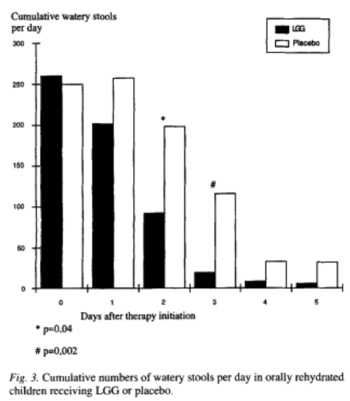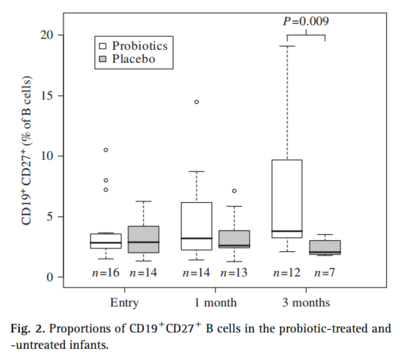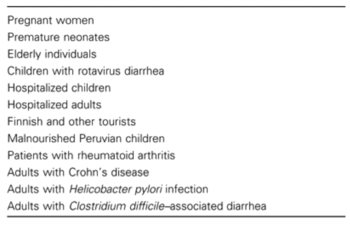Lactobacillus rhamnosus GG (ATCC 53103) and its Probiotic Use
Lactobacillus rhamnosus GG (ATCC53103) is a Gram-positive bacterial strain of the Lactobacillus rhamnosus species that was isolated in 1983 by Barry R. Goldin and Sherwood L. Gorbach (hence the surname letters GG) (Lee, 2009). It is one of the most widely studied bacterial strains due to its use in probiotics and its lack of pathogenicity. Lactobacillus rhamnosus GG primarily exists in the human digestive system, but can also be found in the human urinary and genital tracts (Lee, 2009). It is also used in various food products, usually dairy products such as yogurt, fermented milk, pasteurized milk, and semi-hard cheese. Lactobacillus rhamnosus GG is generally known to help maintain a “good balance” of bacteria in the stomach and intestines by preventing the growth of harmful bacteria. Because the probiotic use of Lactobacillus rhamnosus GG is relatively new, it had not yet been approved by the FDA to treat any disease (Dartmouth-Hitchcock Cancer Center). However, the first commercial use of probiotics with Lactobacillus rhamnosus GG was launched in Finland in 1990 under the Gefilus® brand, which has since developed various Lactobacillus rhamnosus GG products including buttermilks, yoghurts, milk, fruit drinks, "daily dose" drinks and fermented whey-based drinks (Figure 1) (Lee, 2009).
Probiotic Pathways

Copyright © 2013 National Academy of Sciences
Source
Lactobacillus rhamnosus GG is known for its robust character and ability to survive the acid and bile of the human stomach and intestine. Lactobacillus species, as members of the lactic acid bacteria, play important roles in diverse food fermentation processes. Furthermore, Lactobacillus rhamnosus GG is particularly useful in probiotics because of its ability to adhere to cells, colonize the intestine, exclude or reduce pathogenic adherence, persist and multiply, produce compounds antagonistic to pathogen growth, resist vaginal microbicides and form a normal, balanced flora (Reid, 2009). The ability of Lactobacillus rhamnosus GG and other Lactobacillus species to adhere to intestinal cells promotes a variety of specific interactions with the human host to balance microflora in the gastrointestinal system and is therefore one of the most widely studied mechanisms of Lactobacillus rhamnosus GG. Moreover, consumption of Lactobacillus rhamnosus GG for probiotic use has been shown to correlate with responses to specific bioactive molecules and pharmaceuticals (van Baarlen et al., 2011). Lactobacillus rhamnosus GG mechanisms have been mostly studied in the context of mucosal processes due to its significance in medical applications.
Genomic Analysis
The following study used comparative and functional analyses of Lactobacillus rhamnosus GG's genomic sequences to explain some of the molecular mechanisms in these host-microbe interactions. They found genes that encoded for pili and pili assembly proteins elucidating its ability to adhere to intestinal cells. They also identified genes predicted to encode glycosidases which participate in the conversion of complex polysaccharides to simple carbohydrates—a mechanism that could have significant biological and medical implications. Moreover, to better understand the adhesion abilities of Lactobacillus rhamnosus GG they encoded for and found host colonization and adhesion genomic domains, but found only one mucosal-binding domain, which was thought to be a major adhesion mechanism (Kankainena et al, 2009).
In order to characterize the molecular mechanisms between Lactobacillus rhamnosus GG and the human host, the study conducted complete genome sequences for Lactobacillus rhamnosus GG and Lactobacillus rhamnosus LC705 (an industrial strain commonly used in as a starter culture for dairy products). Both strains are among the largest sized lactobacilli genomes, with the genome of Lactobacillus rhamnosus GG sized at 3.01 Mbp (average Lactobacillus species genomes are ≈2Mbp), 2,944 genes, and average gene size of 873 bp, and no plasmids. The genome sequencing identified five genomic islands in strain GG that are predicted to encode 80 unique proteins with lengths of 100 residues or more. The genomic islands were not conserved between closely related strains of bacteria, suggesting that they had been transmitted by horizontal gene transfer and exhibit specialized biological functions. They found that the genomic islands in Lactobacillus rhamnosus GG had the capacity to transport or metabolize sugars (GGISL1, LCISL1, LCISL2, and LCISL4), produce specific exopolysaccharides (GGISL5 and LCISL3), and 2 islands were enriched with phage-associated genes (GGISL3 and GGISL4). Furthermore, the GGISL2 island contained genes that encoded for 3 pili proteins (SpaCBA) and a sortase, which is required for pili assembly, features that are characteristic of colonization and host-interactions for gram-positive bacteria. Images of Lactobacillus rhamnosus GG show multiple pili structures near the cell poles that help the bacteria adhere to gastrointestinal cells. (Figure 2) (Kankainena et al., 2009).
This study also found that compared to other species of lactobacilli, Lactobacillus rhamnosus GG had 143 unique proteins and 24 of them were related to carbohydrate transport and metabolism. Lactobacillus rhamnosus GG uses a variety of mono-and disaccharide substrates, which is a metabolic activity considered advantageous for bacteria residing in the carbohydrate-rich proximal region of the small intestine. They found that its genome encoded a set of phosphotransferase system transporters (PTS) and carbohydrate-metabolizing enzymes utilized in metabolic network reconstruction, which is important in keeping a "good balance" of bacteria in the gastrointestinal system. Also, because the mucus-binding capacity of Lactobacillus rhamnosus GG is thought to be sensitive to protease, they speculated that a protein-mediated strain-specific adhesion was responsible for the high binding properties of Lactobacillus rhamnosus GG . The comparative genomic analysis identified multiple types of proteins (31 in GG and 37 in LC705) with domains related to adhesion and host colonization. Surprisingly, only a single protein in both genomes (LGG_02337 in GG and LC705_02328 in LC705) contained a mucus-binding domain. (Kankainena et al., 2009).
Cellular Pathway Analysis
The interaction between natural microbiota and human mucosa is essential for proper intestinal function and the study of mucosal interactions with Lactobacillus rhamnosus GG have suggested mechanisms for probiotic use (van Baarlen et al., 2011). The following study examined in vivo mucosal responses of healthy adults to three probiotic strains, L. acidophilus , L. casei , L. rhamnosus GG . They had volunteers consume all three probiotic samples and a placebo control. After a 6 hour period biopsies were taken from the duodenum. Analysis of mucosal transcriptomes revealed that the human mucosa demonstrated fast and specific responses on perception of each bacterial strain. They compared these responses with specific expression and response profiles of pharmaceutical and other biologically active compounds. They found that the responses correlated significantly with responses to compounds active in regulation of immune responses, cell cycle, blood pressure, and water and ion homeostasis. Specifically Lactobacillus rhamnosus GG was found to be involved in wound healing, IFN response, and Ion Homeostasis, suggesting various mechanisms for probiotic use (van Baarlen et al., 2011).
Probiotic Applications
Because Lactobacillus rhamnosus GG is generally found in the human gastrointestinal system, most studies investigating its medical applications have tested the use of Lactobacillus rhamnosus GG in the treatment or prevention of gastrointestinal diseases and infections, overall demonstrating positive clinical outcomes. However, several papers have also tested the use of Lactobacillus rhamnosus GG for diseases and infections in other areas of the human body such as atopic dermatitis, urogenital infections, allergic reactions, dental caries, and nasal pathogens (Goldin and Gorbach, 2008). While these studies show mixed results and this area of research is relatively new, the use Lactobacillus rhamnosus GG continues to be a novel therapeutic approach to various medical conditions.
Gastrointestinal Diseases and Infections

Copyright © 1997 Scandinavian University Press
Source: http://onlinelibrary.wiley.com/doi/10.1111/j.1651-2227.1997.tb08913.x/pdf
There are several studies that have reported the use of Lactobacillus rhamnosus GG to either treat or prevent various forms of diseases and infections in the stomach and intestines. The most common use for Lactobacillus rhamnosus GG is to treat diarrhea symptoms in acute diarrhea, Traveler’s diarrhea, and antibiotic associated diarrhea. Most of these studies have been conducted with infants or children.
Acute Diarrhea
Lactobacillus rhamnosus GG has been demonstrated to be effective in the treatment and prevention of acute diarrhea in young children with the probiotic use Lactobacillus rhamnosus GG. The European Society for Pediatric Gastroenterology, Hepatology, and Nutrition conducted the most extensive trial using Lactobacillus rhamnosus GG for the treatment of moderate to severe diarrhea in children with 287 children aged 1-36 months from 10 countries (Manreau et al., 2001). They found that patients who received Lactobacillus rhamnosus GG had decreased severity and shorter duration of the illness, a shorter hospital stay, and decreased likelihood of persistent diarrheal illness than patients who did not take Lactobacillus rhamnosus GG supplements (Marteau et al., 2001). Another study was done with 137 children aged 1-36 months who were admitted to the hospital with severe diarrhea (Shornikova et al., 1997). The children given Lactobacillus rhamnosus GG showed a substantial decrease in the cumulative number of watery stools and duration of illness (Figure 3). Similar studies have been conducted in Thailand and Pakistan in which treatment with Lactobacillus rhamnosus GG substantially lowered duration and severity of symptoms (Goldin and Gorbach, 2008). One preventative study was performed with undernourished children aged 6-24 months in Peru that showed a significant decrease in the rate of incidence of diarrhea among children who received Lactobacillus rhamnosus GG who were not being breast-fed (Goldin and Gorbach, 2008).
Traveler’s Diarrhea
Lactobacillus rhamnosus GG is also effective in the treatment and prevention of Traveler's Diarrhea. It is common for travelers in less-developed countries with warmer climates to experience the debilitating symptoms of Traveler’s diarrhea. Traveler's diarrhea is known to occur in about 50% of travelers who visit high-risk areas (Marteau et al., 2001). One study was conducted in which American tourists were given capsules containing Lactobacillus rhamnosus GG powder or a placebo (Hilton et al., 2006). The study found that the risk of having diarrhea on any given day was 3.9% for those receiving the Lactobacillus rhamnosus GG capsules compared with the 7.4% for individuals receiving the placebo and the impact of Lactobacillus rhamnosus GG did not vary as a function of gender or age (Hilton et al., 2006)
Antibiotic-Associated Diarrhea (ADD)
Studies have demonstrated positive results for the treatment of ADD with Lactobacillus rhamnosus GG. Diarrhea has been reported to occur in a little under 20% of patients who clinically use antibiotics (Marteau et al., 2001). ADD is caused by a microbial imbalance that decreases the fermentation capacity of the colon and the endogenous flora that is usually responsible for colonization resistance (Marteau et al., 2001). A study of 119 children who received antibiotics for respiratory infections and during the first two weeks after antibiotic treatment had an ~70% reduction in diarrheal symptoms than patients receiving the placebo (Goldin and Gorbach, 2008). Another study with 202 children receiving oral antibiotics found that 8% of children who received Lactobacillus rhamnosus GG with their antibiotics experienced diarrheal symptoms compared with 26% who received the pacebo (Marteau et al., 2001) A study with adults found that patients who received antibiotic treatment to kill Helicobater pylori and also received Lactobacillus rhamnosus GG experienced significantly less nausea and diarrhea (Marteau et al., 2001)
Atopic Dermatitis

Copyright © 2010 Blackwell Publishing Ltd
Source
Studies have been conducted in the use of probiotics with Lactobacillus rhamnosus GG in the prevention and treatment of atopic dermatitis (a type of eczema). These studies have been conducted primarily with mice and recently some studies have emerged with young children and infants with mixed results. Intestinal mucosa functions as a deference barrier against gut antigens. Atopic dermatitis is associated with divergent barrier functions of the skin and in some patients, the gut mucosa. The barrier defect in atopic dermatitis may be due to mutations in barrier proteins or may be due to intestinal mucosal damage caused by reactions to food antigens or microbes.
A study was conducted to characterize the interaction of Lactobacillus rhamnosus GG with skin and gut microbiota and humoral immunity with infants with atopic dermatitis. In a randomized double-blind test, blood and fecal samples were taken from 39 infants for a period of 3 months to determine the number of immunoglobulin-secreting cells by enzyme-linked immunospot. They found that the proportions of IgA-and IgM-secreting cells decreased significantly in the group that received Lactobacillus rhamnosus GG. They also determined the proportion of CD19+CD27+ B cells (memory cells of the immune system that are important in bridging the innate and adaptive immune system) among peripheral white blood cells by flow cytometry and characterized major groups of gut and skin bacteria using PCR. They found that the proportions of CD19+CD27+ B cells significantly increased in the treated patients compared to the placebo group (Figure 4). The decrease in immunoglobulin-secreting cells suggests that in the presence of constant stimulation of gut intraluminar antigens, there was an increase in gut barrier function in infants treated with Lactobacillus rhamnosus GG. Moreover, the increase in CD19+CD27+ B cells, illustrates and important mechanistic effect of Lactobacillus rhamnosus GG and indicates an increase in immune response with the use of Lactobacillus rhamnosus GG (Nermes et al., 2011).
On the other hand, a study with 3-12 month infants diagnosed with atopic dermatitis revealed no therapeutic effect of Lactobacillus rhamnosus GG. While symptoms generally improved overtime, statistical analysis revealed no significant differences. They concluded that symptoms improved with age, regardless of therapeutic regimen (Grüber et al., 2007).
Consequently, because the limited number of trials clinical trials have demonstrated mixed results and the mechanism in which Lactobacillus rhamnosus GG affects the atopic dermatitis symptoms has yet to be identified its therapeutic use remains controversial. The scientific basis for probiotics against established atopic dermatitis treatment needs to be further researched.
Safety of Probiotic Use

Source
Lactobacillus rhamnosus GG and other probiotic strains of lactobacilli are rare causes of human disease or infection. Humans are frequently exposed to Lactobacillus rhamnosus GG in daily life, primarily in dairy products, and Lactobacillus rhamnosus GG is naturally found in human gastrointestinal systems. The use of Lactobacillus rhamnosus GG supplements for medical applications has been widely studied and has been found to be safe for all age groups and even immune-compromised individuals (Snydman, 2008). Figure 5 lists various groups of people that have been tested for the safety of probiotic use (Snydman, 2008). Furthermore, Lactobacillus rhamnosus GG also carries no significant resistance to antibiotics that would compromise probiotic use with patients receiving antibiotic treatment in conjunction with the probiotic supplement or prevent treatment in the case of a rare probiotic infection (Goldin and Gorbach, 2008). Nevertheless, Lactobacillus rhamnosus GG has not yet been approved by the FDA for the treatment of any disease or infection (Dartmoth-Hitchcock Cancer Institute). Between September 2000 and January 2001 a workshop took place in which recognized experts on probiotics convened to advise and lead manufacturers (Dannone, Nestlé, Valio, and Yakult) on the safety of probiotic use of lactobacilli species (Boriello et al., 2003). Cases of infection due to lactobacilli and bifidobacteria are estimated to account for 0.05%-0.04% of cases of infective endocarditis and bacteremia (Boriello et al., 2003). Increasing consumption of probiotic lactobacilli, particularly Lactobacillus rhamnosus GG, has not led to any increase in infections levels in consumers. For example, in Finland, for the years of 1995-1999, the number of cases of infections maintains a consistent level of 10-20 cases per year, a mean incidence of 0.2% (Boriello et. al, 2003). While Lactobacillus rhamnosus GG should not yet be relied on to treat or prevent any disease, consuming Lactobacillus rhamnosus GG supplements or food products containing Lactobacillus rhamnosus GG is universally harmless. Lactobacillus rhamnosus GG relatives have even been appearing in advertisements of food products that promote digestive and overall health.
Conclusion
Lactobacillus rhamnosus GG has generally been shown to be beneficial in its use in probiotics for general digestive health and gastrointestinal diseases due to its ability to encode for proteins related to carbohydrate transport and metabolism and its ability adhere to gut and intestinal mucosa. Furthermore, the use of Lactobacillus rhamnosus GG has proven to be safe among a variety of gender, age, and health groups. Mixed results for the studies of Lactobacillus rhamnosus GG in the treatment and prevention of atopic dermatitis indicate that further research needs to be conducted in this area. However, the molecular mechanisms of Lactobacillus rhamnosus GG and its relation to atopic dermatitis indicate a promising future for its use in probiotics. Emerging areas of study for the use of Lactobacillus rhamnosus GG in probiotics include the treatment of joint symptoms and diabetes. There have animal studies and one human trial that suggest that Lactobacillus rhamnosus GG may alleviate joint symptoms (Goldin and Gorbach, 2008). Another study indicated that Lactobacillus rhamnosus GG could lower levels of blood hemoglobin A1c and improve glucose tolerance for animals with diabetes (Goldin and Gorbach, 2008). While research in this area has been new and limited, Lactobacillus rhamnosus GG has been shown to treat and prevent diseases and infections that treat a variety of recurring and problematic diseases. Lactobacillus rhamnosus GG is a refreshing example of a natural, prevalent drug used for probiotics among the popular discussion of harmful microbes and antibiotics.
References
7. Lee, Y. K., and Seppo Salminen. Handbook of Probiotics and Prebiotics. Hoboken, NJ: John Wiley & Sons, 2009.
14.Valio Gefilus® Functional Products. Accessed March 6, 2013
Edited by (Hannah Whittemore), a student of Nora Sullivan in BIOL187S (Microbial Life) in The Keck Science Department of the Claremont Colleges Spring 2013.

